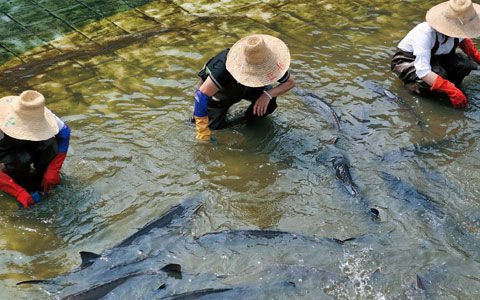
(Ecns.cn)--The Xiaonanhai Dam, a controversial hydropower project planned for the upper reaches of the Yangtze River, has been criticized for threatening the region's last nature reserve for rare and endangered fish species.
In a little-noticed ruling made public on December 14 last year, the State Council approved changes that would reduce the size of the "Rare and Endemic Fishes Nature Reserve."
Critics of the ruling have cited the Gezhouba Dam project, saying it blocked migration routes for Chinese Surgeons, and the Three Gorges Dam, which reportedly reduced the number of four major Chinese carp species by 90 percent.
"The Xiaonanhai Dam, once built, will interfere with fish migration between the lower and upper reaches of Yangtze River," said Cao Wenxuan, an academician at the Institute of Hydrobiology under the Chinese Academy of Sciences.
"The conservation zone is the last stretch of free-flowing water on the Yangtze that is absolutely essential for the reproduction of many rare fishes," Li Bo, head of Friends of Nature, said in an interview with The New York Times. "Once the border of the conservation zone is moved, those fish will not have enough space to reproduce."
"This is almost the last reserve for the whole river basin, especially after the construction of Three Gorges," said Guo Qiaoyu, Yangtze River project manager for The Nature Conservancy in Beijing. "There will be dramatic damage to these kinds of species."
A recent survey shows that from March to July in 2007, nearly 16 billion young fish passed through the Yangtze's Xiaonanhai section, but the number dropped to 14 billion in 2008. The survey estimates that around 10 billion rare young fish in the upper reaches would disappear after the dam is built.
"It's not often that a project could lead to the extinction of over 10 species. It should be given serious thought," said a Chinese ecologist.
There are also strong doubts about the benefits the development will bring.
Statistics from The Nature Conservancy show that the dam's annual energy output would only be 3 percent of the average amount produced by the Three Gorges Dam and another four hydroelectric stations along the lower reaches of the Yangtze. Yet the total investment for Xiaonanhai is 2-4 times as high as its neighboring dams.
Critics say the 32-billion-yuan project makes little economic sense except as a temporary job creator. The reservoir will flood 18 square miles of prime farmland and displace 400,000 people, driving the cost of every kilowatt of generating capacity to $2,144—triple that of the Three Gorges Dam, Fan Xiao, a geologist who has fought the project for years, told The New York Times.
"The Xiaonanhai Dam is not important. The amount of energy that this dam would produce will not take care of the entirety of Chongqing Municipality's energy needs by a long, long way. They have to bring electricity in from outside in either event, whether they build this dam or not," David Harrison, senior advisor to The Nature Conservancy's Global Freshwater team, explained in an interview with Global Times.
Harrison also pointed out the contradictions between construction planning and environmental protection employed by the project's leaders.
"In many countries, not just in the U.S. or Europe, the first step is to see if there are alternatives that could accommodate both, giving them the energy and keeping the fish reserve," he said. "It seems that they decided first that the Xiaonanhai Dam should be built, and then thought about justifying it, rather than asking 'Should it be built' or 'Are there better alternatives?'"
In response to the criticism, the Chongqing government has proposed a remedy to save the endangered species by using artificial propagation.
For some, that idea doesn't hold water. Wei Qiwei, a researcher at the Chinese Academy of Fishery Sciences, recalls that there were 2,000-6,000 Chinese sturgeons in the Yangtze in 1984, before the Gezhouba Dam was built. 16 years later, the population had fallen to less than 500.

Copyright ©1999-2011 Chinanews.com. All rights reserved.
Reproduction in whole or in part without permission is prohibited.